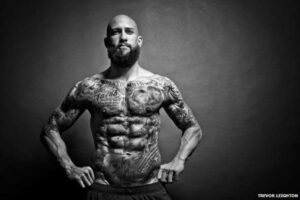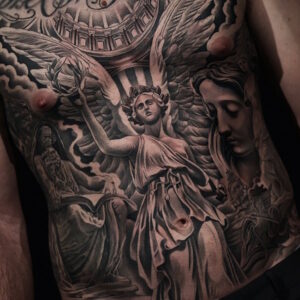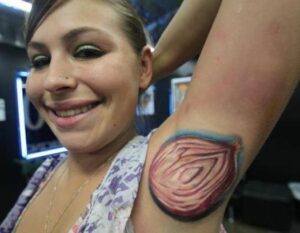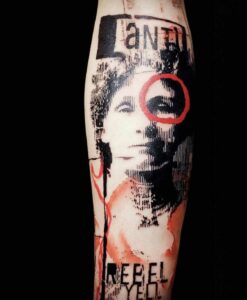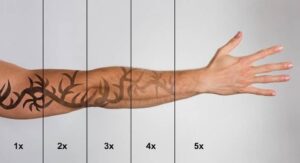Meet Maud Wagner – the first female tattoo artist in the USA, a renowned circus artist and probably the most tattooed woman of her time.
Maud Stevens Wagner – America’s first female tattoo artist – was born in Kansas in 1877. She was a circus performer, an acrobat, aerialist, and contortionist. For most of her adult life, she worked in various traveling circuses passing through the whole country.

In the early 1900s – 1904 to be exact – Maud met Gus Wagner while working within the Louisiana Purchase Exposition (World’s Fair) in St. Louis. This life event would not only change Maud’s life and career, but also the way we look at her artistic heritage today.

Meeting Gus Wagner
Augustus “Gus” Wagner – known as the “Tattooed Globetrotter” and “the most artistically marked-up man in America”, was a well-known tattoo artist at the time and also one of the last tattooists in America to only work by hand, strictly using the old school stick-and-poke method. There’s a lot of speculation about how exactly Maud and Gus met in St. Louis.
Some sources claim that Gus offered Maud free tattoo lessons in return for a date, while others say it was Maud that demanded lessons in exchange for the said date.
One way or another, it is obvious that Gus Wagner had the chance to teach Maud how to do a tattoo, not only on other people but on her own body as well. The date between the two must have been good. They became an item and artistic partners shortly after.
Inked and badass
It didn’t take long before Maud got the ink under her skin, withal remarkable dedication. She soon became covered in tattoos and used this to become a circus show attraction.
Maud’s tattoos are “typical of the period” (according to M. DeMello in “Inked: Tattoos and Body Art Around The Word”) and consisted of “patriotic”* tattoos and basic designs of faces and animals – monkey, butterflies, lions, horses, snakes, trees and women among others. Maud Wagner also had her own name tattooed on her left arm.
*History shows that many of the early American tattoos tended to be memorial tattoos. During the times of the Civil War, most tattoo artists worked near battlefields, creating designs in memory of fallen soldiers, comrades and relatives. Military life and general American patriotism were also popular themes for tattooing at the time.
Tattoos in the 1900’s
Tattooing wasn’t exactly widely spread in the general public but was a regular occurrence in circuses and side-shows. It wasn’t until 1891 when Samuel O’Reily invented and got a patent pending for his early design of the tattoo machine in New York that tattoos truly grew in popularity. O’Reily used Thomas Edison’s “electric pen” design, and thus allowed the bloom of a new era in tattooing.
However, people saw tattooing as lower-class in the early 1900s, and it was also very difficult to find a respectable tattoo artist as there were no regulations. Of course, mostly due to demand, tattoo suppliers existed, but they weren’t publicly advertised and there were no official shops. You had to be “introduced” to “the Man”.
At the time Maud Wagner lived tattooing was still looked down upon. At the turn of the 20th Century tattoos were still rare: in 1936 Life Magazine said that only 6% of people had a tattoo.
Over 300 completely tattooed individuals have been known to be employed in various carnivals, circuses and “freak shows”, often earning as much as $ 200 or even more on a weekly basis ( the rough equivalent of $ 2000 today).
Delinquent Habits
Most people considered inked and altered people to be either members of gangs or delinquents. A small portion of tattooed people, however, came from the upper class, as tattooing wasn’t cheap either.
Tattooed women in particular – usually younger and barely-clad – used to be a highly sought-after spectacle in circuses and sideshows throughout the country.
Show business
After some time working together, Gus and Maud married. They moved from performing in circuses to much smaller vaudeville houses, county fairs, and amusement arcades.
Regarding tattoo history in America, the Wagners hold credit to bringing tattoo artistry inland from the US coastal towns and cities.
Hand-poked
Inspired by her husband’s methods, Maud Wagner kept using the fully manual stick-and-poke approach exclusively. Electric tattoo machines were already becoming widely available and frequently used by other artists, but Mrs. Wagner chose to stick with the original customs and practices.
Maud mastered the skills of tattooing and then passed it on to her daughter – Lovetta Wagner. An interesting and lesser known fact is that Maud refused to let Gus tattoo their own daughter. This resulted in Lovetta being one of very few tattoo artists without a tattoo. Lovetta decided that if her father can’t tattoo her, then she would not get ink by anyone else.
The Wagners’ legacy
Maud Wagner passed away on January 30, 1961, in Lawton, Oklahoma. She lived most of her life being one of the very few female tattoo artists in America.
The Wagners were also two of the very few artists in the world to become specifically renowned for their stick-and-poke tattoo work. It is also very likely that Maud Wagner is the only woman to achieve this renown.
She died one of the most famous manual old school stick-and-poke tattoo artists of America. Mrs. Wagner also passed a legacy that lived on through her daughter Lovetta.





